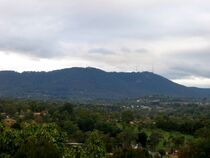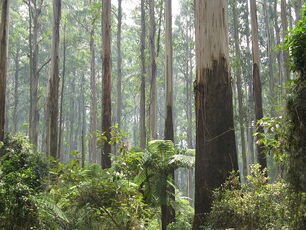| Dandenong Ranges | |
|---|---|

| |
Some attributes
| |
| First | Peak:
Mount Dandenong |
| Second | Elevation:
633 m (2,077 ft) |
| Third | Parent range:
Great Dividing Range |
Other attributes
| |
The Dandenong Ranges (commonly just the Dandenongs) are a set of low mountain ranges, rising to 633 metres at Mount Dandenong, approximately 35 km east of Melbourne, Victoria, Australia. The ranges consist mostly of rolling hills, steeply weathered valleys and gullies covered in thick temperate rainforest, predominantly of tall Mountain Ash trees and dense ferny undergrowth.
After European settlement in the region, the range was used as a main source of timber for Melbourne. The ranges were popular with day-trippers from the 1870s onwards. Much of the Dandenongs were protected by parklands as early as 1882 and by 1987 these parklands were amalgamated to form the Dandenong Ranges National Park, which was added to again in 1997. The range experiences light to moderate snow falls a few times most years, frequently between late winter and late spring.
Today, the Dandenongs are home to over 100,000 residents and the area is popular amongst visitors, many of which stay for the weekend at the various Bed & Breakfasts through the region. The popular Puffing Billy Railway, a heritage steam railway, runs through the southern parts of the Dandenongs.
Etymology[]
The etymology of the Dandenongs is a complicated one. Two names have been used to refer to the ranges; Corhanwarrabul and Dandenong, both derived from the Woiwurrung language of the Wurundjeri people.
It is suspected that the name Dandenong was applied to the ranges because Danden

Sherbrooke Forest
ong Creek originates there, however, the original name for Dandenong Creek was Narra Narrawong. It is not known where the name Dandenong came from nor what it means, or even its correct spelling, other variations include; Tanjenong, Tangynon and Bangeong. In any case, both names relate at least to watercourses in general, and not to mountains or ranges, as indicated by the ong ending.
So as the name Dandenong may not actually apply to anything in the immediate area, the relevance of the name Corhanwarrabul becomes apparent. Carhanwarrabul (pronounced either "corhan-warrabul" with a silent "h", or "cor-hana-warrabul") was the original name for one of the two main summits, perhaps both or perhaps the entire range. The name applied to the main summits and was in continued use up until around 1900, when the name Dandenong appeared. At any rate, Corhanwarrabul remains the most relevant name for the ranges to date.